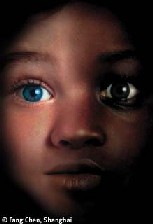| |
 |
 |
|
 |
 |
|
 |
 |
|
 |
| Colour, nation, ethnic hate... : Why racism? |
 |
| Once founded on the traditional notion of "race", racial discrimination today comes in many guises, whether based on one's colour, nation (xenophobia), ethnic belonging or caste. This dossier looks at its roots and impact on indigenous groups and black communities in Latin America, the lowest castes in Asia, and foreigners in Africa and Western Europe. Echoing the World Conference against Racism (2001), we strive to give a voice to the hundreds of millions of victims around the world. |
 |
 When it comes to dealing with racism, “silence is the worst attitude” says Lilian Thuram, member of France’s World Cup-winning football team. Echoing his remarks, NGOs campaigning in the run-up to the World Conference against Racism (Durban, South Africa, August 31-September 7) have insisted that the voices be heard of the hundreds of millions of people around the world who are still victims of racial discrimination. When it comes to dealing with racism, “silence is the worst attitude” says Lilian Thuram, member of France’s World Cup-winning football team. Echoing his remarks, NGOs campaigning in the run-up to the World Conference against Racism (Durban, South Africa, August 31-September 7) have insisted that the voices be heard of the hundreds of millions of people around the world who are still victims of racial discrimination.
Institutional racism, the last incarnation of the myth that certain “races” are born inferior, died with the end of apartheid. Dating back to the Renaissance, nourished by religious then scientific thought, it reached its culmination with Nazism (pp. 21-23). Although the myth is flatly discredited today, its legacy lives on, as the status of blacks in South America goes to prove (pp. 24-26).
Most importantly, the decline of racist ideology does not signal the end of racial discrimination, grounded, as the UN stipulates, on “race, colour, or ethnic origin.” Victims of this “veiled apartheid” are no longer discriminated against in the name of biological “inferiority,” but because of religious tradition—the lowest castes in India (pp. 27-29)—or economic and political instability, which is fuelling waves of xenophobia in black Africa (pp. 30-32). Discrimination also occurs in the name of “cultural difference,” deemed so profound that harmonious co-existence becomes impossible. Many indigenous peoples, like the Mapuche in Santiago, Chile (pp. 18-19), are in this position. So are millions of immigrants in Western Europe (pp. 33-35), where racism does not appear to be simply “spontaneous”: rather, it is intricately linked to tensions generated by globalization (pp. 36-37).
More ... (Archives, The UNESCO Courier, September 2001) |
| |
 |
|
 |
 |
 Email this page Email this page  Printable version Printable version
|
 |
|
|


